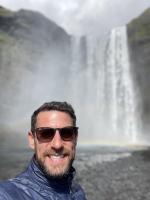
Entering the European market for nature tourism
European nature travellers are keen to enjoy immersive travel experiences in natural surroundings and they seek pristine landscapes with few tourists. There are many activities that can be enjoyed in nature destinations such as hiking and walking, cycling, bird watching, wildlife watching, rafting, and wellness. Clear sustainability measures are important to this traveller segment and it is increasingly important that operators are certified sustainable in order to succeed in this competitive market.
Contents of this page
- What requirements must nature tourism comply with to be allowed on the European market?
- Through what channels can you get nature tourism on the European market?
- What competition do you face on the European nature tourism market?
- What are the prices for nature tourism products on the European market?
1. What requirements must nature tourism comply with to be allowed on the European market?
The main requirement to attract European tourists is to ensure your nature-based tourism experience is sustainably managed to minimise environmental impact. Europeans are very environmentally-conscious and want their travel to have the lowest possible carbon footprint. There is a high demand for sustainable and responsible holidays, and local operators that actively take steps to minimise the impact of tourism on their destination are more likely to succeed in this competitive marketplace.
What are mandatory and additional requirements?
The mandatory and additional requirements for nature tourism apply across the sector and include:
- The European Package Travel Directive
- General Data Protection Regulation (GDPR)
- Liability Insurance and Insolvency Protection
You can learn more about them in CBI’s study What are the requirements for tourism services in the European market? The study will help you understand the legal, non-legal and sector-wide requirements that European tour operators must comply with. If you understand these requirements and can adapt your business to meet them, European tour operators will be more likely to do business with you. It is important to European buyers that they can trust their suppliers to meet their own and their customers’ needs.
Embedding sustainability into a nature tourism business
Making sure your tourism business is sustainable is an essential part of nature tourism. The purpose of sustainable tourism is to increase the benefits and reduce the negative impacts of tourism. Sustainable tourism includes:
- Protecting the natural environment, wildlife, natural habitats and other natural resources when planning, developing and managing tourism activities.
- Providing tourist experiences that are authentic so that the unique culture and heritage are preserved and celebrated.
- Empowering local people and communities through employment, economic independence and skills development.
More and more European tour operators will only work with suppliers who are certified or can prove their sustainability credentials. For example:
- TUI, Europe’s largest tour operator, expects all its accommodation providers to be sustainably certified by a standard recognised by the Global Sustainable Tourism Council (GSTC).
- As from 2024, German tour operator ASI Reisen aims to work only with suppliers who are sustainably certified.
- Exodus is a well-regarded UK adventure travel operator that has embedded sustainability throughout its business to ensure its trips improve life for people, places and the planet.
There are many sustainable certification programmes available for nature-based tourism. For example, The Long Run’s Global Ecosphere Retreats (GER) standard is recognised by GSTC and is awarded to businesses that work according to the 4Cs of sustainability: conservation, community, commerce and culture. The Long Run is a membership community of nature-based tour operators committed to sustainable tourism at the highest level.
Sustainable tourism is directly related to nature tourism. If you do not put sustainability at the centre of your business, you will not succeed in this niche.
What are the requirements for niche markets?
The main requirements in the nature tourism sector are related to sustainability. Destinations that are unspoiled, well managed and receive few tourists are the most appealing to European travellers. It is essential that tourism does not negatively impact the natural landscape. This can be achieved through the careful implementation and measurement of sustainable actions.
There is overlap between nature-based tourism, ecotourism, wildlife tourism and community-based tourism (CBT) as they all tend to be conducted in nature. Today, sustainability is the foundation of all these niches and European buyers will not do business with you if you cannot prove that your product is sustainable. Most tour operators ensure their trips meet the relevant sustainable development goals (SDGs) established by the UN.
Tip:
- Learn about the sustainable goals and familiarise yourself with the accompanying icons, which are widely used in tourism.
Figure 1: The UN Sustainable Development Goals (SDGs)
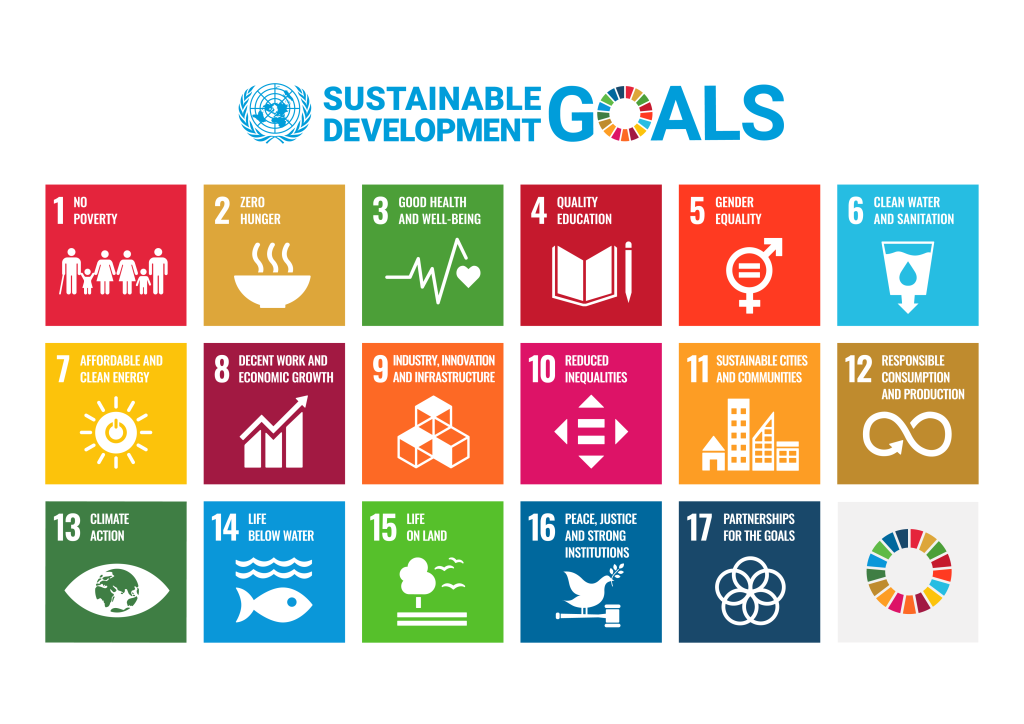
Source: United Nations
Standards and certifications
National parks all over the world are subject to strict management and conservation regulations. If your business is in or near a park or reserve, make sure you know what the rules are. Most have a website describing the regulations in place. See these examples so you know what to look for: Nyungwe National Park Rules and Regulations (Rwanda) and Torres del Paine National Park (Chile).
The International Standards Organisation (ISO) develops and publishes international standards to help businesses become certified. ISO 18065 is related to tourist services provided by Natural Protected Areas Authorities for public use. This includes areas where ecotourism may take place such as protected forests, conservation areas and so on.
There are many published resources about sustainable nature-based tourism that you can consult to make sure your business meets best practice standards and regulations:
- Supporting Sustainable Livelihoods through Wildlife Tourism, World Bank. This publication explains how wildlife and nature-based tourism can help destinations diversify their economies, protect the environment and wildlife, empower local communities and contribute to the SDGs.
- Tourism and visitor management in protected areas, IUCN (Union for Conservation of Nature). These guidelines provide tourism managers with guidance on achieving sustainable tourism in protected areas.
- Tourism for Nature and Development – A Good Practice Guide (PDF), CBD (Convention on Biological Diversity). This guide contains some good case studies to learn from.
- Tourism Product Development – Interventions and best practices in sub-Saharan Africa, Part 1: Synthesis and Part 2: Case Studies, University of Johannesburg. Provides some innovative actions relating to sustainable tourism.
- Compendium of Best Practices and Recommendations for Ecotourism in Asia and the Pacific, UNWTO (must be purchased online).
- Guía para las mejores prácticas ee ecoturismo en Aáreas protegidas (Guide for Best Ecotourism Practices in Protected Areas, PDF), Comisión Nacional para el Desarrollo de los Pueblos Indígenas (in Spanish only). Developed for Mexico.
Take a look at the website of Sustainable Travel International, which works with businesses and individuals to build a better way forward for some of the world’s most vulnerable destinations. The website provides a lot of information about how to protect nature, fight climate change, empower communities and tackle waste and pollution.
European buyers will be impressed if you are a member of an organisation such as Sustainable Travel International as it is a very public way of demonstrating your commitment to sustainability. The infographic below shows how your membership helps.
Figure 2: How your membership helps
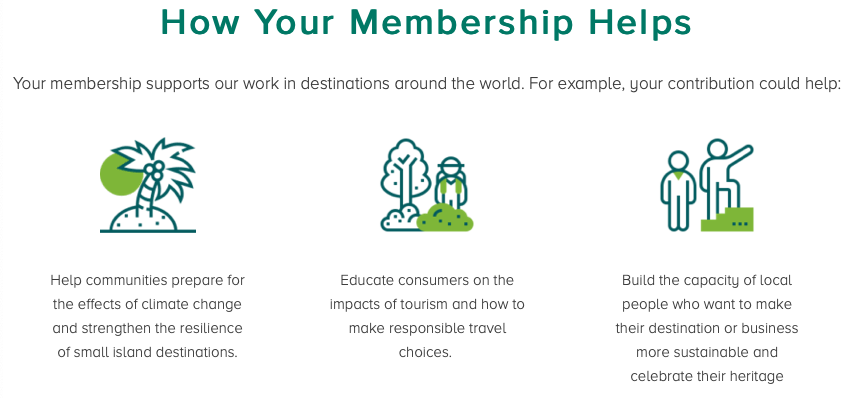
Source: Sustainable Travel International
Practical requirements for nature-based tourism providers
There are many opportunities to develop a nature-based tourism business in an area of outstanding natural beauty. Outdoor activities include hiking/trekking, walking, cycling, birdwatching, wildlife watching, safaris, camping, climbing, rafting, canoeing/kayaking, ecotourism, community-based tourism, fishing and wellness.
The main requirement for any nature-based tourism product is that it is located in a natural environment. This includes but is not limited to all types of forest (boreal, temperate and tropical), deserts, savannah and plains, mountains and valleys, rivers and hills, coastal regions, wetlands and marine areas. A huge range of activities can be enjoyed in such locations.
Table 1: Requirements for setting up a nature-based tourism project
| Requirements for setting up a nature-based tourism project |
Central requirements
|
Environmental requirements
|
Sustainability requirements
|
Requirements to develop a range of activities
|
Requirements for accommodation providers
|
Source: Acorn Tourism Consulting
Tip:
- To help you plan your nature-based business, download Towards Nature Positive Travel & Tourism – Toolbox (PDF), by the World Travel & Tourism Council (WTTC) and ANIMONDIAL. This practical study accompanies the Nature Positive Travel & Tourism (PDF) report, outlining the theory of nature positive travel and tourism. The toolbox helps tourism operators integrate a nature-positive approach into their business based on a roadmap with four phases.
Figure 3: Nature Positive Tourism Roadmap
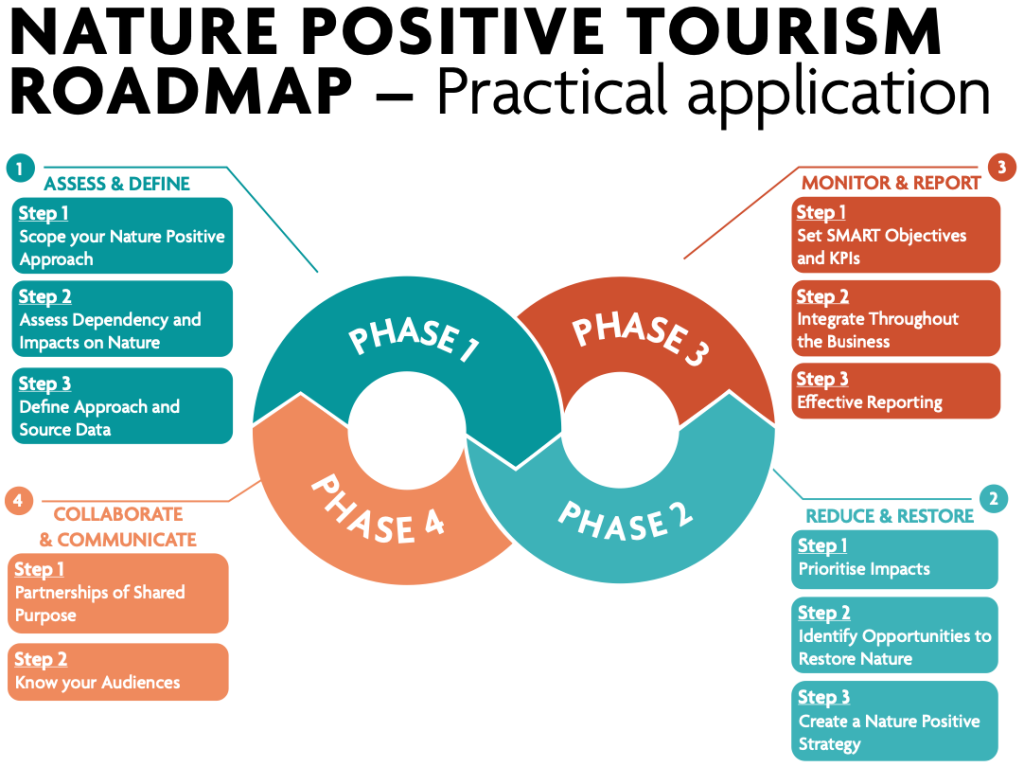
Source: WTTC, ANIMONDIAL
2. Through what channels can you get nature tourism on the European market?
How is the end market segmented?
Nature-based tourists are motivated by untouched natural landscapes, being out in nature, viewing birds and wildlife and getting away from it all. They also like to take part in outdoor activities, particularly hiking, trekking and walking. They are also keen to meet and engage with local communities for an immersive, cultural experience.
Nature tourists also share characteristics with adventure tourists. Adventure tourists overlap with all the main consumer groups. These are baby boomers (born between 1946 and 1964), Gen X[A1] (born between 1965 and 1980) and millennials/Gen Y (born between 1981 and 2000). These groups can be further categorised by how much money and time they have to spend on travel.
CBI has published several niche market studies relevant to the nature-based tourism market. They all focus on opportunities in the European market for:
Tip:
- Consult the CBI study The European market potential for nature tourism for more information on nature tourists.
Through what channels do nature tourism products end up on the end market?
European tour operators, travel agents and online travel agents (OTAs) are the main providers of nature and ecotourism products on the European market. Additional direct sales are made to ecotourists by local providers, ecolodges and destination management companies (DMCs). The chart below shows the various sales channels.
Travelife for Tour Operators is another GSTC standard that is widely recognised by European buyers.
Tip:
- Read the CBI study How to be a sustainable tourism business to help you make the right decisions for your nature-based tourism business.
Figure 4: Sales channels for nature-based tourism products
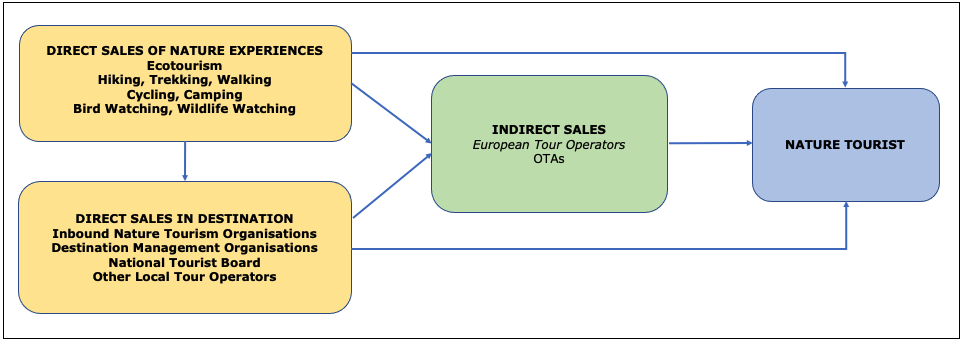
Source: Acorn Tourism Consulting
Each channel is explained below.
Direct sales are sales made directly from your website or in person/over the phone. They also include sales to inbound tour operators and destination management companies (DMCs), and sales to European tour operators and/or FITs (fully independent travellers). FITs book directly with local tour operators. They research their trips extensively on the internet. If you want to target them, you will need a good website and social media marketing strategy.
Indirect sales are sales made to European tour operators and OTAs. They sell tourism products indirectly to European travellers.
European tour operators usually offer a range of different experiences in their nature packages. Some are specialised in for example trekking, cycling, wildlife/safaris or birdwatching, others are general adventure operators. Examples include:
- France – Terres d’Aventure, Allibert Trekking, Mondélios
- Germany – Natürlich Afrika, Natur- und Erlebnisreisen, Chamäleon Reisen
- Netherlands – SNP Natuurreizen, All for Nature, ExperienceTravel
- UK – G Adventures, Journey Latin America, Naturetrek, Wildfoot Travel
OTAs that offer trips and experiences are the fastest-growing sales channel in the sector. Many are looking for new suppliers. Bookatrekking (Netherlands) specialises in trekking to remote and more difficult mountainous destinations. SafariBookings (Netherlands) specialises in trips to Africa and is a well-respected OTA. Others include Yugen Earthside (France), Positive Travel (Germany) and Responsible Travel (UK).
Mynatour specialises in ecotourism and responsible travel and is expanding beyond Europe to destinations including Guatemala and India.
Tip:
- To find new buyers, read CBI’s tips for finding buyers in the European tourism sector.
What is the most interesting channel for you?
European tour operators and OTAs are both interesting channels for nature-based tourism products.
OTAs are a quick route to market. However, you must do your research first as every OTA is different and has different types of customer that they market to. OTAs are popular among FITs.
Building relationships with European tour operators takes longer, but when you find the right one it should be a mutually beneficial partnership.
Tips:
- Build strong business relationships with all your buyers. Consult CBI’s tips for doing business with European tourism buyers and tips for organising your tourism exports to Europe for more information.
- Read the CBI study How to work effectively with OTAs? to learn how to research and work with OTAs.
- Improve or build your own website. Download the CBI study How to be a successful company online? for tips.
3. What competition do you face on the European nature tourism market?
Which countries are you competing with?
Developing countries have some of the world’s most spectacular natural environments and the landscapes are very diverse and varied. Worldwide, nature is one of the most popular reasons for travelling, so you have many competing countries in your region. This study profiles Brazil, Dominica, Ethiopia, Indonesia, Peru and Tanzania as examples of nature tourism destinations.
Areas of volcanic activity also offer good opportunities for nature tourism. The Pacific Ring of Fire extends through several countries in east Asia and Latin America. Examples of countries with notable volcanoes and nature tourism include: Costa Rica (Arenal), Democratic Republic of Congo (Mount Nyiragongo), Ecuador (Cotopaxi), Guatemala (Acetanango), Nicaragua (Cerro Negro) and the Philippines (Mayon).
Table 2: Nature tourism destinations by geographical feature
| Tropical rainforest | Desert | Savannah | Mountains |
| Africa | |||
DRC Ghana Madagascar Nigeria Rwanda Uganda | Egypt Namibia South Africa | Botswana Kenya Malawi South Africa Tanzania Zambia Zimbabwe
| DRC Ethiopia Kenya Lesotho Morocco Rwanda South Africa Tanzania Uganda
|
| Asia | |||
Cambodia India Indonesia Laos Sri Lanka Thailand Vietnam
| India Mongolia | India | China Indonesia Mongolia Myanmar Nepal Philippines Thailand Vietnam
|
| Latin America | |||
Belize Bolivia Brazil Colombia French Guiana Guyana Nicaragua Peru Suriname Venezuela
| Argentina Bolivia Chile
| Argentina Bolivia Brazil
| Argentina Brazil Bolivia Chile Colombia Costa Rica Ecuador Guatemala Nicaragua Peru |
Source: Acorn Tourism Consulting
Brazil
The Amazon Rainforest is the largest rainforest on earth. It covers 1.4 billion acres and extends into nine countries. Brazil is home to the largest part of the rainforest. As one of the world’s largest carbon stores, this area is now a major global conservation priority for limiting global warming. Two Brazilian organisations, Associação Brasileira de Normas Técnias (ABNT) and the Brazilian Ecotourism and Adventure Tourism Trade Association (ABETA), developed the ISO Adventure Travel Standard 21101, which is used around the world.
Tourism is a key sector in Brazil, which welcomed 6.4 million international tourists in 2019. In the first four months of 2022, tourist arrivals increased 60% compared to the same period in 2021. Brazil wants to increase visitor numbers and the Brazilian Ministry of Tourism has been investing in developing the tourism sector. For example, in programmes that support small businesses along 30 tourist routes to provide strong tourism products that appeal to European and other international markets.
Brazil also wants to attract more visitors to its nature offering, although environmentalists are concerned about the negative impacts on important sites of biodiversity. In recent years, Brazil has identified sustainable tourism as an important way to boost economic development while also preserving natural heritage. Its huge and varied landmass of great biodiversity offers excellent opportunities for nature-based tour operators.
Iguazú National Park, home to the Iguazú Falls, is a major attraction that receives around 1.5 million visitors a year. Another popular nature destination is the remote Pantanal Wetlands, which attract 1 million visitors a year. The Pantanal is known for sightings of jaguars and the hyacinth macaw, the world’s largest parrot. The best way to explore the rainforest is by boat, and Manaus is a common starting point for jungle expeditions.
Dominica
Dominica is known as the ‘Nature Island of the Caribbean’. It is a lesser-visited island with a strong cultural identity that is closely linked with its extraordinary natural landscape. It is a volcanic island rich in natural resources and home to the world’s second-largest hot spring, Boiling Lake. Ecolodges and tourism accommodation are being developed on sustainable principles, and there are three national parks on the small island. The indigenous population is very active in providing tourism.
Dominica is becoming better known as an ecotourism destination. It has high aspirations to become the world’s first climate-resilient nation by building robust infrastructure. You can read more in this news article: Dominica gaining popularity among eco-tourists seeking a peaceful atmosphere.
Ethiopia
Ethiopia has many natural attractions and pristine wilderness. It is one of the earliest sites of human life and its ancient roots are steeped in culture and both the Christian and Islamic religions. It is also thought to be where coffee beans were first produced. The Ethiopian Highlands are part of Africa’s largest continuous mountain range, part of the Rift Valley of lakes and mountains. The Danakil Depression was formed by the shifting of three tectonic plates and is known as the hottest place on the planet. It also has salt lakes, lava lakes, volcanos and hot springs.
Although internal conflict has affected the Ethiopian tourism industry, the country is popular among visitors who want to explore its natural environment. The 10-year Sustainable Tourism Plan (2015-2025) has a strong focus on ecotourism that benefits and empowers local communities through activities that support the conservation of its natural attractions and the preservation of cultural identities. In 2019, there were 812,000 international tourist arrivals.
Indonesia
Indonesia is famous as an archipelago of 17,000 islands including Flores, Komodo, Bali, Mount Batur, Raja Ampat Islands, Gili Islands and Banda Islands. Much of Indonesia is volcanic as it is located on the Pacific Ring of Fire. It has an incredibly diverse landscape that is rich in plant life and wildlife, including orangutans, leopards and the famous Komodo dragon. It has 54 national parks, of which six are World Heritage Sites, nine Biosphere reserves and five wetlands of international importance.
Indonesia is a leading tourism destination and welcomed 15.5 million tourists in 2019. Ecotourism, which is strongly linked to nature tourism, accounts for around 35% of its tourism revenue. According to Statista, the national parks reported more than 7.8 million international and local visitors in 2018.
Peru
Nature tourism, which often includes ecotourism, is driving tourism industry growth in Peru. Tourism has been growing at a rate of 25% annually over the past five years, faster than in any other country in South America. More than 4.4 million international visitors were reported in 2019 and the country is recovering well since the pandemic. Visitors give Peru a high satisfaction rating (94%).
Peru’s biodiversity is very extensive, covering three geological regions of Amazon rainforest, Andes Mountains and Pacific coastline. Each offers visitors variety and opportunities to experience nature at its extremes. Responsible tourism is widely integrated and helps empower local communities and contributes to sustainable development and conservation. Peru’s most famous tourist attraction is Machu Picchu, a World Heritage Site, which is also a good example of how a country can address undesirable impacts of overtourism.
Over the period from the 1980s to 2019, visitor numbers to Machu Picchu increased by unsustainable numbers from around 100,000 to more than 1.5 million in 2019. New regulations were put in place to embed sustainability in running the site, including by managing visitor numbers and directing visitor flow along circuits and routes. All visitors must now be accompanied by a licensed tour guide. You can learn more in this local tour operator blog about new rules for Machu Picchu in 2023.
Tanzania
Tanzania is a globally recognised destination for nature tourism, including wildlife safaris, community-based tourism and ecotourism. Tanzania has some of the world’s best-protected parks and reserves for spotting African wildlife, such as the Serengeti and Ngorongoro Crater. It is also home to Mount Kilimanjaro, Africa’s highest peak. 1.4 million international tourists visited Tanzania in 2019 and tourism is its second-largest economic sector. In 2022, international tourism was back at 2019 levels.
Tanzania has designated 25% of its land as protected for wildlife conservation and has 16 national parks, 28 game reserves, 44 game-controlled areas and 1 conservation area. The Tanzanian government has regulations in place to protect its delicate ecosystem, which is under threat from climate change and other societal and natural factors. Sustainable tourism has been identified as key to addressing these issues and is focused on attracting high-income tourists in smaller numbers as well as long-term transformation of the sector.
Table 3: Arrivals to competing destinations by source markets, 2019
| Source market | Belgium | Czech Republic | France | Germany | Netherlands | Poland |
| Brazil | 28,178 | 7,442 | 257,504 | 206,882 | 59,752 | 22,041 |
| Dominica | 274 | 315 | 7,423 | 1,500 | 268 | 289 |
| Ethiopia | 8,128 | n/a | 25,623 | 36,858 | 14,667 | n/a |
| Indonesia | 46,780 | 23,941 | 283,814 | 277,653 | 215,287 | 41,637 |
| Peru | 16,953 | 6,030 | 108,873 | 86,307 | 36,526 | 10,815 |
| Tanzania | 16,885 | 6,389 | 56,297 | 67,284 | 26,161 | 21,332 |
Source: UNWTO
Key takeaways:
- Nature, ecotourism and community-based tourism are closely linked. Most destinations offer a combination of activities under the same description. Sustainability must be embedded into all tourism activities in these sectors.
- Nature tourism can be practised anywhere there is suitable landscape that is pristine, undeveloped and sustainably managed. Assess the natural environment in your destination to identify where there are gaps in the market.
- Find out what nature-based tourism regulations are in place in your destination. Contact your national tourist board and/or ministry of tourism to see what you can source.
Which companies are you competing with?
As nature, ecotourism and sustainability are closely linked, most local tour operators in the nature tourism sector offer trips with a mix of experiences. Connecting all the activities is a focus on sustainability by making positive contributions to local communities while preserving wildlife and/or conserving local environments.
Companies in Brazil
Nas Alturas specialises in adventure and ecotourism and is based near Chapada Diamantina National Park. It has a strong focus on traveller safety and offers checklists with important advice. It is an ABNT-certified adventure company that complies with the ISO Adventure standard. It offers a range of multi-day and short tours and provides a lot of useful information about the destination. Being specialised in one region, this operator can promote itself as the expert in the region and in what it has to offer.
Pantanal Safaris is a locally-owned and operated nature tour company specialised in wildlife tours and jaguar photography in the Pantanal. All their guides are experienced and grew up and live in the Pantanal. Its trips range from 5 to 16 days and expeditions are in remote wilderness destinations. Their expertise in the field enables them to read animal behaviour to get the best photos.
Pantanal’s website is professional and features many good photographs, as you would expect from a photography specialist. The tagline highlights its unique selling point: Capture the Moment. The website has a blog page with useful tips for travellers and many five-star testimonials. There is also a chat box that pops up for users to ask questions.
Companies in Dominica
Just Go Dominica is a local operator that provides small group and private tours for those seeking ‘exclusive connections’ with the Nature Island. This is a clear unique selling point. Their mission is ‘quality, safety and sustainability’ whilst respecting nature in Dominica. All guides are certified and trained by the Discover Dominica Authority and also trained in first aid and CPR (cardio-pulmonary resuscitation) by the Dominica Red Cross.
The website is attractive and inspirational. It makes good use of photos, captions and calls to action to tempt users to interact with the site. Though users cannot book directly on the website, there is a clear contact form. There is also plenty of information, including detailed FAQs (frequently asked questions), as well as social media links and a very good customer testimonial.
E Voyage Dominica offers tours of Dominica for land-based visitors and cruise ship excursions. The founder, Elvis, is a local tour guide who offers a wide range of experiences, including nature tours. The focus is on conservation, cultural immersion and ensuring that ‘visitors have a complete and authentic experience of our island’. These personal touches are very appealing to European travellers.
The website is very detailed with a lot of useful information. Users can download an attraction map and resources from the blog. This includes a hiker checklist for what to take on the Waitikubuli National Trail, one of Dominica’s major attractions. It also has sponsored links to relevant publications about Dominica on Amazon, which is a way to generate additional funds.
There is a useful page with information for outbound tour operators that are looking for new suppliers, and inbound DMCs seeking local operators for customers.
Companies in Ethiopia
SimienEcoTours started out in 2010 offering tours in the Simien Mountains. Since then, it has expanded to offers tours all over Ethiopia. In 2016 it launched training programmes for its guides and teams. During the pandemic, the company worked to embed sustainability throughout its business and is also working towards Travelife certification.
It lists its commitments in a clear way, including accommodation and activities that are sustainable to minimise harmful environment impacts and support local communities. The infographic below shows their ‘Price and Quality Promise’.
Figure 5: Commitment to sustainable tourism
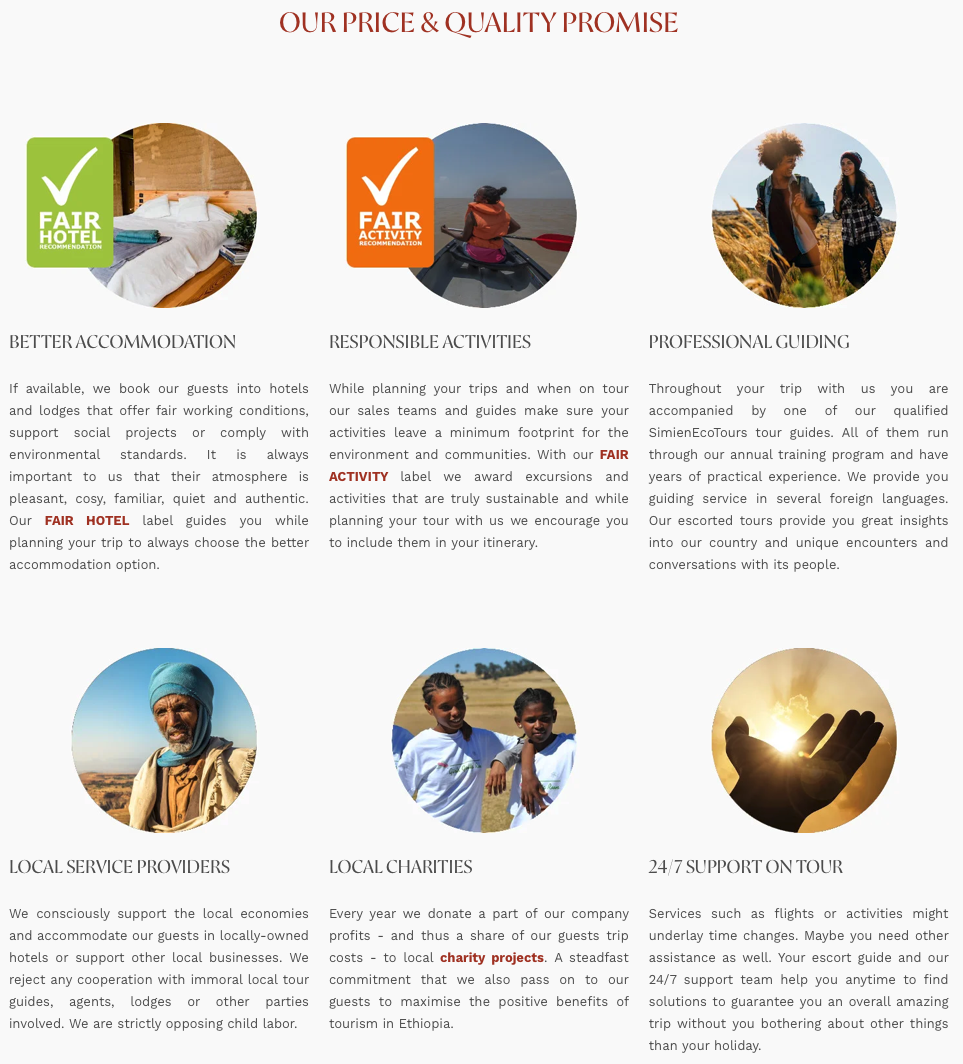
Source: SimienEcoTours
Inside Ethiopia Tours calls itself the ‘Inside Experts’ and offers tailor-made responsible and authentic travel experiences for FITs and groups. The website clearly states the mission, vision and values of their business. This is reassuring for European travellers who look for local operators with integrity. They care about the planet and construct itineraries that do not harm the natural environment or communities that depend on it. Their sustainability policy is also published online.
Ethiopia is currently suffering from political instability and some areas of the country are not safe for travel. This operator has written a blog that explains the situation in detail, giving potential visitors the information they need to decide whether to visit areas deemed safe to visit. If your destination has similar issues, it is a good idea to be honest about it as European travellers value honesty.
Companies in Indonesia
Altaï Indonesia specialises in organising nature and adventure travel in Indonesia. Trips are grouped by theme and include hiking and outdoor trips, multi-adventure trips and travel to unknown areas. The operator is committed to quality, fair prices, environmental and cultural preservation and excellent customer service.
On the website, Altaï gives four reasons to travel with them in a simple infographic that sends a strong message:
Figure 6: Why choose Altaï Indonesia?

Source: Altaï Indonesia
Sumatra Orangutan Explore offers ethical treks and ecotours and opportunities to discover the jungle in an ethical way. It specialises in trips to Gunung Leuser National Park, home to the endangered Sumatran orangutan. The park is also a World Heritage Site. Its eco-friendly day tours and activities are designed to support the local community of Bukit Lawang and its traditions. Guides speak English and are certified by the Indonesia Tourist Guides Association.
Its website is detailed and informative, with many good photos and appealing design features. It names all the partners it works with and their logos all link through to those organisations. Strict rules to keep the jungle clean and wildlife safe are also published on the website.
Companies in Peru
Quechuas Expeditions is a licensed Inca Trail tour operator based in Cusco. It is a ‘100% local tour operator’, which makes it an attractive proposition for European travellers seeking local experts. The operator leads tours throughout Peru, to the Andes, the Amazon jungle, Titicaca Lake and Colca Canyon. Some accommodation is provided in Sky Lodge Domes, which are geometric structures that healers believe mirror the molecules of the body and boost health and creativity.
The operator has consistently been awarded annual TripAdvisor Certificates of Excellence, which are prominently displayed on the site. The website has several good design features. It expands on the operator’s commitment to the environment, animal welfare, porter welfare and sustainable tourism, among other things, using a pictorial menu as shown below:
Figure 7: Website design feature for individual pages

Source: Quechuas Expeditions
Manu Wildlife Tours specialises in jungle tours in the Manu National Park, a World Heritage Site and one of the best destinations for nature tourism. This specialist focus means they channel their efforts into providing small numbers of trips very well. Their trips visit either Manu’s reserved zone (wildlife) or cultural zone (nature and culture). Accommodation is provided in community-owned lodges in the park.
Companies in Tanzania
Green Tours Tanzania promotes safaris and ecotourism trips that ensure conservation of natural resources, preservation of local culture and economic benefits to communities. Ecotourism and nature tourism are strongly connected throughout Africa. The operator’s website is professional, detailed and informative. They partner with a number of national and African tourism organisations and are listed on SafariBookings. Also included on the site are short biographies and headshots of the team, which is a friendly approach.
Green Tours Tanzania caters for all budgets and provides detailed information about the accommodation levels offered. It lists its green credentials and says it aims to work with travellers to ensure their trips are sustainable. The operator also publishes its commitment to recycling and supports a range of local initiatives for communities in deprived areas.
Nature Discovery offers safaris, mountaineering and trekking holidays. Responsible tourism is at the forefront of its activities. It is Travelife Partner-certified and also partners with other organisations that are committed to sustainable tourism. It was awarded Best Responsible Tour Operator in the Responsible Tourism Tanzania (RTTZ) Awards in 2018 and 2019. It is very effective at monitoring its sustainable actions and focuses on evidence-based certification of its responsibility.
Key takeaways:
- If your business is in a specific area, position yourself as an expert on experiences in that region to stand out from your competitors.
- If you do not have a website, consider building one. European travellers use the internet extensively to plan and book trips. Online website builders are easy to use and reasonably priced for small businesses. For more advice, see the CBI study How to be a successful company online?.
- Do you know what your unique selling point (USP) is? Make sure it is clear on your website. For help defining a USP, read the CBI study How to determine your Unique Value Proposition?.
- Assess your website objectively. Ask yourself questions such as: Is it attractive and appealing? Are there plenty of well-displayed images and videos? Are there some good design features? European buyers are attracted to well-designed websites. Talk to your web developer to find out how to make the right changes.
- Make sure your website has enough information to encourage European tour operators to contact you as a potential supplier. Your website is your ‘shop window’, so ensure it is fit for this purpose.
- Clearly and accurately describe your sustainability credentials on your website, even if you are not yet certified. However, do not overstate your efforts, which is known as greenwashing and will harm your reputation when discovered.
- Tell customers how you will keep them safe. Give them checklists of things to be aware of and tips for travel and what to pack. This information is useful for travellers and may incentivise them to book with you.
- Your guides should be trained, speak your visitors’ language to a good level and be able to communicate well. Find out from the national tourist board if there are any national training programmes for tourist guides in your destination.
Which products are you competing with?
Nature tourism competes with adventure tourism, ecotourism and CBT. European travellers are likely to do many different activities on one trip, particularly if they have travelled a long way. All of these tourism products are therefore competing for European travellers’ attention.
Tips:
- Learn more about competing products. Consult the following CBI studies: What are the opportunities on the European ecotourism market?, ‘What are the opportunities for community-based tourism from Europe?’ and What are the opportunities in the European market for adventure tourism? for more information about these specialist niches.
- Look at CBI’s interactive infographic on which European tourism market segments and niches you should target to see how tourism niches and segments overlap.
4. What are the prices for nature tourism products on the European market?
Prices in the nature tourism segment vary widely. Costs for travellers usually consist of several different elements such as guides, park fees, food, accommodation, transportation and contributions to local projects and/or communities. Prices are often higher for smaller groups. You should be clear about your pricing structure if this is the case.
The table below gives an indication of current price ranges on this market. Prices for holidays exclude international airfares. Research was conducted in February 2023.
Table 4: Prices of nature-based tourism products, 2023
| Trip | Country | Duration | Price per person € |
| Swim with Pink Dolphins | Brazil | 1 day | 51 |
| Meet the Orangutans on a Trek in the Jungle | Indonesia | 1 day | 55 |
| Tour to Iguazu Falls | Brazil | Half day | 57 |
| Snorkelling, Waterfall and Hot Springs Tour | Dominica | 6.5 hours | 65 |
| Morne Diablotin Mountain Hiking Tour | Dominica | 7.5 hours | 93 |
| Natural Pools and Panoramic Camping | Indonesia | 2 days | 100 |
| Titicaca Lake Tour | Peru | 2 days | 112 |
| Ausangate Rainbow Mountain Trip | Peru | 1 day | 112 |
| Introduction to Dominica | Dominica | 3 days | 168 |
| Mount Kilimanjaro, Caves, Waterfalls and Culture | Tanzania | 2 days | 187 |
| Hiking Adventure to Zala Waterfall | Ethiopia | 2 days | 205 |
| Canoe Safari in Arusha National Park | Tanzania | 1 day | 233 |
| Nature Escape at Lake Tana's Northern Shore | Ethiopia | 4 days | 307 |
| Volcanic Crater and Old Forest | Ethiopia | 2 days | 347 |
| Inca Jungle Trail to Machu Picchu | Peru | 3 days | 372 |
| Selous Reserve, Nyerere Park Boat, Drive and Walking | Tanzania | 3 days | 402 |
| Jungle Tour at Juma Floating Lodge plus camping | Brazil | 5 days | 447 |
| Jungle Camping Tour from Anavilhanas Lodge | Brazil | 4 days | 503 |
| North Sulawesi – Fauna, Volcanoes and Coral Reefs | Indonesia | 7 days | 720 |
Source: Acorn Tourism Consulting
Tips:
- Do your own research to find typical prices for nature-based tourism products in your destination. Be sure to compare ‘like for like’ (or as similar as possible) to assess if your product offers value for money.
- Consult the CBI study ‘10 tips for doing business with European tourism buyers’, and specifically Tip 7: Set a fair price for your services.
- For more advice on setting prices, download this guide published by Destination New South Wales: Pricing your tourism product (PDF).
Acorn Tourism Consulting Limited carried out this study on behalf of CBI.
Please review our market information disclaimer.
Search
Enter search terms to find market research
